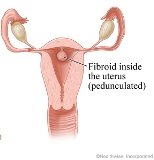
What are fibroids? Fibroids are small growth and tumors made of smooth muscle cells and fibrous connective tissue that develops in the uterus. It is estimated that 70 to 80 percent of women will develop fibroids in their lifetime, not everyone will develop symptoms or require treatment.

“The most important characteristic of fibroids is that they’re almost always benign, or noncancerous. However, that said, some fibroids begin as cancer — but benign fibroids can’t become cancer. Cancerous fibroids are very rare. Because of this fact, it’s reasonable for women without symptoms to opt for observation rather than treatment”.
Types of Fibroids Different types of fibroids cause different symptoms. For example-
- Subserosal fibroids develop on the outside of the uterus. This type of fibroid often causes back pain and frequent urination as a Subserosal fibroid presses against the bladder and nearby organs.
- Intramural fibroids are noncancerous growths that develop between a woman’s uterine muscles. These fibroids can be located in the back of the uterus (posterior intramural fibroids) or at the front of the uterus (anterior intramural fibroids).
- Pedunculated fibroids attach the uterine walls with a peduncle (stalk-like) growth. These fibroids can develop outside the uterus (subserous pedunculated fibroids) or inside the uterus (pedunculated submucosal fibroids).
- Submucosal fibroids develop on the uterus’s inner layer (submucosal layer). These fibroids grow into the cavity of the uterus and can block or distort a woman’s fallopian tubes, causing infertility. Submucosal fibroids often result in heavier periods. For more information on Fibroids please Visit: https://www.rosewellness.com/symptoms-of-fibroids-after-menopause/